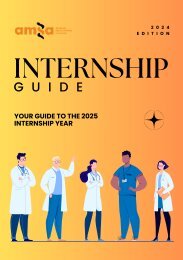AJGH Nexus - Volume 17 2023
AMSA Journal of Global Health (AJGH) 2023 Issue "Nexus"
AMSA Journal of Global Health (AJGH) 2023 Issue "Nexus"
You also want an ePaper? Increase the reach of your titles
YUMPU automatically turns print PDFs into web optimized ePapers that Google loves.
ased guidelines of 100-120 compressions per<br />
minute at a depth of 1/3 of the chest cavity,<br />
with inconsistencies in non-rebreather mask<br />
use for ventilation.[1] Further to that, junior<br />
doctors were being taught how to perform<br />
compressions during the resuscitation.<br />
I asked my peers, when are you trained in<br />
CPR and BLS? They responded, on the job. As<br />
a further impact of poverty on the delivery of<br />
healthcare, it emerged that universities are<br />
not adequately resourced to provide formal<br />
CPR training to future medical professionals,<br />
so that senior doctors and nurses are forced<br />
to teach junior doctors ‘on the job’ whenever<br />
the opportunity arises. Between 24-hour<br />
shifts at the hospital and an endless stream<br />
of significantly unwell patients, these<br />
opportunities tend to present themselves<br />
only in emergency situations when CPR is<br />
required. The observed barriers were clear;<br />
this was a finance-limited, time-limited,<br />
resource-limited clinical and educational<br />
environment in which structured CPR<br />
teaching was essentially impossible. I wanted<br />
to find out more about this, and whether we<br />
know what effect a paucity of formal CPR<br />
training may have on patient outcomes.<br />
The existing evidence on CPR outcomes in<br />
cardiac arrests in the setting of low- and<br />
middle-income healthcare systems is limited<br />
but reveals some surprises. There was no<br />
literature on CPR outcomes in tertiary<br />
hospitals in Cambodia and it would be remiss<br />
to apply sweeping generalisations of<br />
conclusions in other settings to this<br />
situation. However, a retrospective study<br />
performed in a tertiary hospital in Karachi,<br />
Pakistan, sought to unravel these outcomes.<br />
[2] To compare the two low-income<br />
countries, Cambodia’s GDP (Gross Domestic<br />
Product) per capita is $1625.2 USD, while<br />
Pakistan’s is $1505.0 USD according to the<br />
World Bank, where GDP per capita can inform<br />
the economic status of a country and<br />
measure its growth.[3] For reference,<br />
Australia’s GDP per capita is $60,443.1 USD.<br />
Using Pakistan as an example of a lowincome<br />
model, Moosajee US et al. (2018)<br />
analysed 8 years' worth of inpatient data of<br />
cardiac arrests in an emergency department<br />
to determine several outcomes including the<br />
rate of ROSC and survival to discharge (STD) -<br />
both key outcomes in determining CPR<br />
effectiveness. They found that 27.4% of<br />
cardiac arrest patients achieved ROSC and<br />
7.5% reached STD.[2] Out-of-hospital cardiac<br />
arrest (OHCA) patients achieved ROSC and<br />
STD at lower rates, 21% and 4% respectively.<br />
[2] In comparison, an Australian/New<br />
Zealand study by Bray J et al. (2022) found<br />
that outcomes for OHCA patients in the ED<br />
were ROSC 28% and STD 13%.[4] While<br />
differences in ROSC are minimal, the<br />
differences in STD in a lower income setting<br />
versus a higher income setting is significant,<br />
and depends on multiple factors including<br />
pre-hospital, emergency department and<br />
inpatient factors.[2]<br />
These studies suggest that pre-hospital<br />
factors appear to be key in addressing<br />
discrepancies between OHCA patient<br />
outcomes in low- and middle-income<br />
countries compared with higher-income<br />
settings such as Australia, given that timely<br />
and effective CPR administration is a strong<br />
predictor of better CPR outcomes. There is<br />
good evidence that high-quality bystander<br />
CPR in OHCA patients and good outcomes<br />
have a positive correlation because of this.[5]<br />
Unfortunately, there is virtually no research<br />
on CPR training for medical professionals and<br />
medical students in low- and middle-income<br />
countries or its impact on CPR provision and<br />
patient outcomes. This highlights an<br />
opportunity to investigate and ultimately<br />
improve the provision of CPR in hospitals as a<br />
vital inpatient factor of cardiac arrest<br />
outcomes. Conversely, Moosajee US et al.<br />
(2018) posited that minimal or absent<br />
community skills in CPR and BLS provision is<br />
an important contributing prehospital factor<br />
to poorer CPR outcomes in the emergency

















